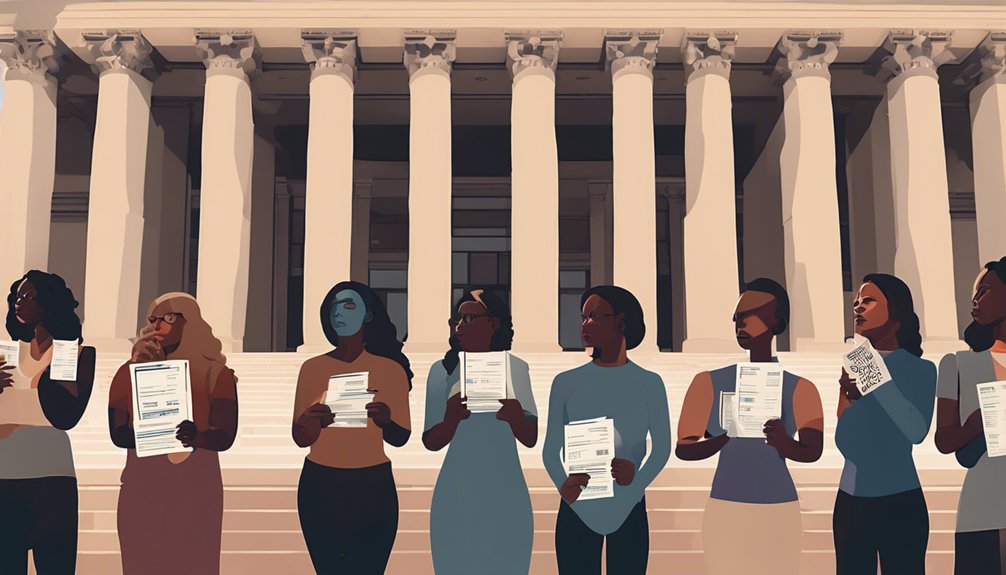Post-Election: What the Future Holds for Trans Rights


Table of Contents
ToggleAs you look ahead, as you consider the impact of elections, as you ponder the future of trans rights, it’s clear there’s a lot at stake. Imagine facing a world where accessing gender-affirming healthcare becomes a maze of red tape, or where simple acts like updating ID documents turn into uphill battles. It’s not just about policy; it’s about real lives and everyday struggles. You might wonder how advocacy groups plan to navigate these challenges and what role you could play in supporting trans rights. The path forward promises to be both complex and critical.
Community advocacy strategies are more important than ever in the fight for trans rights, especially with the political uncertainties ahead. You can take an active role in advocacy by connecting with local and national organizations focused on trans rights. These groups provide community support and legal resources to help you navigate policy shifts that could impact your rights. Scenario planning is key, so staying informed about legal protections and potential changes is crucial. By working together, we can create a strong network of support that addresses the unique challenges faced by trans individuals.
Engaging in community support means more than just attending meetings; it involves building resilience strategies and fostering mutual aid networks. These networks can offer immediate help, especially if you’re considering moving to a more trans-friendly state due to restrictive local laws. It’s essential to keep track of policy shifts and be proactive in safeguarding your rights.
Advocacy doesn’t stop at planning; it extends to raising public awareness and maintaining pressure on policymakers. By participating in advocacy efforts, you’re contributing to a collective voice that demands the protection and advancement of trans rights, ensuring a safer environment for everyone.
As we face the uncertain political landscape, the election’s impact on trans rights becomes a pressing concern. Many transgender individuals worry about losing fundamental rights, especially regarding healthcare and legal recognition. The Trump administration‘s plans to cut federal funding for gender-affirming care could mean considerable hardships. Imagine needing critical healthcare services and suddenly facing barriers due to reduced funding. It’s a reality that many trans people might encounter.
Anti-LGBTQ+ organizations are also hard at work, drafting legislation to restrict access to gender-affirming care and sports participation. This adds another layer of anxiety, as these potential laws could considerably impact your daily life. Imagine being unable to participate in a sport you love or access necessary medical care because of restrictive policies.
Beyond healthcare, the issue of legal recognition looms large. Proposed policies to redefine sex as strictly binary threaten to erase gender-neutral markers on IDs. This complicates legal recognition for transgender individuals, making everyday tasks even more challenging. The hostile political climate, fueled by $215 million in anti-trans advertisements, only intensifies these fears, making it imperative to stay informed and prepared for what’s ahead.

Maneuvering through the maze of legal challenges for changing names and gender markers on identification can feel daunting for transgender individuals. With varying state laws, the process can be a patchwork of obstacles, making it difficult to achieve transgender equality. Some states require proof like gender-reassignment surgery before allowing a gender marker change on identification documents. This requirement, proposed under the Trump administration, complicates matters and can feel invasive.
Imagine needing to present different IDs with a mix of ‘M’, ‘F’, or ‘X’ markers at different stages of your alteration. This inconsistency can lead to discrimination and harassment, highlighting the need for strong legal protections. The Bostock v. Clayton County ruling offers some hope by equating gender discrimination with sex discrimination, yet extensive protections are still necessary.
To navigate these hurdles, you can tap into resources from organizations like Advocates for Transgender Equality, which offer guidance and support. Staying informed and connected with local resources can empower you to tackle these legal challenges. Despite the potential hurdles, working towards uniform identification documents across states remains a crucial step for achieving true transgender equality.
Following the recent election, the future of trans health care and family planning hangs in the balance, sparking widespread concern. Proposed cuts to federal funding for gender-affirming care threaten transgender health care protections and could severely limit access to fundamental medical services like hormones and surgeries. This creates a significant financial burden for many trans individuals, with some facing prohibitive out-of-pocket costs. Take Maddie, for example, who struggles to afford her gender-affirming medications without adequate insurance coverage.
Advocacy groups are stepping up, mobilizing to defend these critical services and emphasize the importance of maintaining legal protections. The Bostock v. Clayton County ruling remains a significant safeguard against gender discrimination, ensuring that you can receive necessary healthcare without being treated unfairly due to your gender identity. Despite political pressures, major medical associations continue to support gender-affirming care, highlighting the consensus on its importance.
It’s imperative to stay informed and involved in advocacy efforts, as these protections provide a lifeline for many. Legal and financial preparations can help navigate these uncertain times, ensuring that your access to health care and family planning remains intact amid evolving political landscapes.

The election’s aftermath threatens to reshape the landscape of trans rights, putting federal funding for gender-affirming care and Title IX protections for trans students at risk. You might feel the weight of these changes, especially with legislative attacks on the rise. Anti-trans laws, like those targeting drag shows and healthcare access for trans youth, highlight the need for advocacy and community solidarity. It’s imperative to understand what these changes could mean for you and your community.
Here are some key points to reflect on:
The community’s resilience and solidarity remain fundamental as you navigate these challenging times.
You can champion change by choosing compassion, creating connections, and challenging misconceptions. Educate yourself and others about trans issues through books, podcasts, or films. Support trans-owned businesses and artists, and share their work widely. Use your voice to correct misgendering or transphobia when you observe it. Donate to trans-focused organizations and offer practical support, like transportation or housing help, to local trans individuals in need. Your actions make a difference.
You play an essential role in advocating for trans rights within educational institutions. Encourage schools to create inclusive policies, like allowing name and pronoun changes in records. Support gender-neutral bathrooms and anti-bullying programs. Push for curriculum that includes LGBTQ+ history and issues. Educators can form alliances with LGBTQ+ groups to provide better resources and support networks. Your active involvement helps foster a safe and affirming environment for trans students.
International perspectives can shape U.S. trans rights policies by shining a light on successful approaches worldwide. When one observes countries like Canada embracing inclusive healthcare or Germany allowing self-identification, it challenges the U.S. to reconsider its stance. Engaging with international human rights organizations and learning from global advocacy can push for progressive changes. By comparing policies, one advocates for a U.S. that values and supports trans rights universally.
You might wonder how trans rights connect to broader civil rights movements. When you support trans rights, you’re actually strengthening the entire civil rights landscape. For example, advocating for trans-inclusive policies often leads to better protections for all marginalized groups. Think about how marriage equality benefited from the groundwork laid by earlier civil rights efforts. By standing with trans individuals, you’re advancing equality and justice for everyone in society.
You can utilize digital platforms by sharing trans stories, connecting with allies, and promoting advocacy campaigns. Use social media to spread awareness and educate others about trans issues. Engage with online communities to support trans creators and amplify their voices. Collaborate on petitions or fundraisers to drive change. By actively participating and sharing content, you help create a more inclusive environment and empower trans individuals in the digital space.
In these turbulent times, you’re like a lighthouse guiding through a storm, standing firm for trans rights. Seize community advocacy like a lifeline, weaving networks that support and empower. Stay informed, because knowledge is your shield against legislative attacks. Picture each action as a stepping stone, paving the way for a brighter future. Remember, your voice is powerful; use it to challenge the tides of uncertainty and push for a world where everyone can live authentically and safely.
Originally posted 2024-11-25 16:13:21.
 Featured PostsDecember 31, 2025Beyond the Headlines: The Full Impact of New Anti-Trans Laws
Featured PostsDecember 31, 2025Beyond the Headlines: The Full Impact of New Anti-Trans Laws Featured PostsDecember 30, 2025Misgendered by Machines: Inside AI’s Discrimination Against Trans People and the Solutions We Need
Featured PostsDecember 30, 2025Misgendered by Machines: Inside AI’s Discrimination Against Trans People and the Solutions We Need News and AdvocacyDecember 21, 2025In Prime-Time Speech, Trump’s Anti-Trans Broadsides Are Branded as Desperate
News and AdvocacyDecember 21, 2025In Prime-Time Speech, Trump’s Anti-Trans Broadsides Are Branded as Desperate Featured PostsDecember 21, 2025Beyond the Binary: A Basic Guide to Transgender Awareness
Featured PostsDecember 21, 2025Beyond the Binary: A Basic Guide to Transgender Awareness